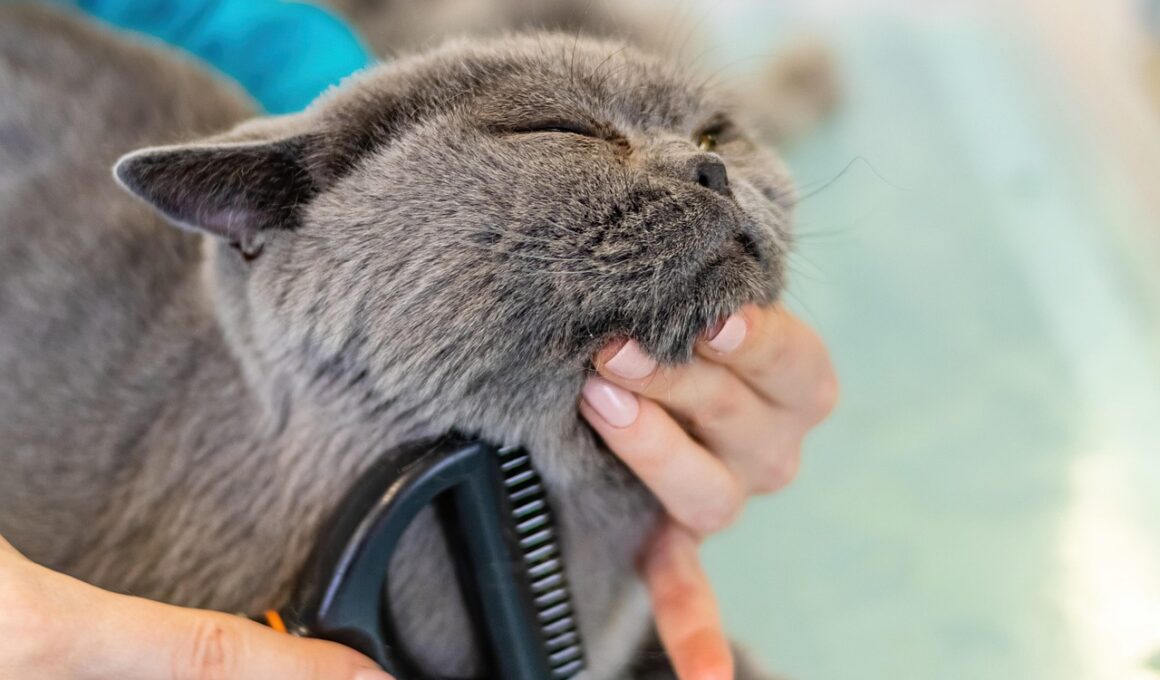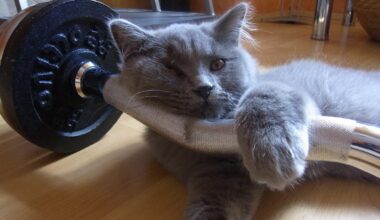How Cats Use Grooming to Communicate
Grooming is a fundamental behavior observed in house cats and feral populations alike, serving various purposes. One primary function is communication. Cats often groom themselves in the presence of others, signaling comfort and safety. This behavior can also serve to reinforce social bonds. For example, grooming each other, known as allogrooming, is key among cats that live together. This behavior highlights affection and trust among feline companions. In contrast, if a cat is grooming excessively, it may signify stress or anxiety. Understanding these nuances is essential for cat owners. Moreover, the grooming process can involve different techniques that reflect a cat’s mood and intent. Certain grooming postures, combined with body language cues, provide insight into what a cat might be feeling. Owners can learn to interpret these signals, helping them to respond appropriately to their feline friends. Ultimately, observing your cat’s grooming habits can foster a deeper understanding of their emotions. Cats use grooming to express various feelings, making it a vital part of their communication method.
Cats also use grooming as a tool for territorial marking. The scent glands located on their paws, face, and other areas contribute to a cat’s scent profile. When they groom, they might spread their scent onto themselves and their surroundings, signaling their presence to other cats. This becomes particularly evident during interactions with other animals. If one cat grooms another, they are not only cleaning but also leaving their mark, establishing a sense of territory. This behavior is particularly prominent in multi-cat households, where maintaining hierarchy is essential. The act of grooming in these contexts serves more than just hygiene, connecting with social structures among felines. Additionally, kittens learn grooming behaviors from their mothers, establishing routines that help them fit into social groups. Such patterns of grooming can influence an adult cat’s approach to grooming and social interaction as well. Understanding this aspect of cat grooming allows us to appreciate more fully the layers of meaning behind this seemingly simple act. Whether they are asserting dominance, expressing love, or marking territory, grooming remains a cornerstone of feline social life.
Another variable to consider is the influence of environmental factors on cat grooming behaviors. For example, stressors in their surroundings may lead to changes in grooming habits, such as over-grooming or neglecting hygiene. Recognizing signs of stress, such as excessive grooming, can help owners mitigate potential issues. Environmental changes like moving to a new home, introducing another pet, or even changes in routine can significantly affect a cat’s well-being. Oftentimes, these changes prompt a cat to react with increased grooming as a coping mechanism. Conversely, some cats may stop grooming altogether, which can result in skin issues if left unaddressed. The role of the owner in a cat’s grooming habits is crucial. Providing a safe and stable environment can help maintain your cat’s natural grooming behaviors. Offering comfortable spaces, toys, and opportunities for exercise can reduce stress and promote healthy habits. Keep in mind that each cat has unique grooming needs and preferences, so being attentive to these nuances will foster a better understanding and improve your relationship with your feline companion.
Understanding Feline Body Language
Body language plays a critical role in our understanding of cat grooming behaviors and communication. When cats are grooming, their body language can reveal much about their emotional states. For instance, a cat that is grooming while sitting upright, with ears perked, may be expressing contentment or relaxation. In contrast, if a cat is grooming aggressively and twitching their tail, it could indicate agitation or discomfort. Recognizing these signs is essential for every cat owner. Furthermore, the relationship between aggressive grooming and anxiety should be explored. Aggressive or obsessive grooming can sometimes lead to fur loss and skin irritations, which indicate that a cat is unwell emotionally. By contrasting relaxation with agitation in grooming behaviors, we can identify when something is amiss. It’s beneficial to observe your cat’s grooming habits regularly. Tap into their body language and variability in grooming patterns to measure health and emotional states. Observing changes in grooming habits can be an early indicator of health concerns or psychological stress, enabling proactive response measures from owners.
Moreover, using grooming as a bonding activity between cat and owner can enhance social interaction. Engaging in grooming with your cat not only promotes hygiene but also reinforces trust and affection between both parties. Cats often respond positively to gentle brushing while enjoying petting and interaction. Taking time to groom your cat can dramatically improve the bond you share. The rhythm of brushing, combined with soft spoken words, helps build a secure and loving environment. This bonding ritual can also relieve stress for both the cat and the owner, fostering intimacy and relaxation. Understanding your cat’s preferences in brushing, including tools and duration, is important. Some cats may enjoy being brushed lightly, while others may prefer a vigorous rub. Additionally, familiarize yourself with areas they like being groomed and those they do not for a more enjoyable experience. Training your cat to accept grooming involves patience and positive reinforcement, so consistently praise them during the process. Creating a loving grooming routine not only enhances physical well-being but also strengthens the emotional connection shared.
Interestingly, grooming behaviors can also vary among different breeds of cats. Certain breeds, such as Siamese or Maine Coons, exhibit distinct grooming habits that reflect their personalities and physical characteristics. For example, long-haired breeds often engage in grooming behavior more frequently due to the maintenance required for their coats. Understanding these breed-specific patterns helps in managing expectations and care for individual cats. Additionally, some breeds have been observed to seek their owner’s assistance more actively during grooming sessions. Their dependence or preference for human interaction can differ significantly. Identifying these patterns can aid owners in forming appropriate grooming routines tailored to their cat’s needs. Furthermore, discussing breed differences with veterinarians or cat behaviorists can underline key aspects to consider. Language surrounding grooming behaviors also varies among different breeds. While some cats may use physical grooming as a means of social interaction, others might display different methods to communicate these same feelings. Recognizing breed-specific grooming behaviors can enhance vital connections between owners and their feline friends, making grooming a more gratifying and insightful experience.
Final Insights and Recommendations
In conclusion, recognizing how cats use grooming to communicate is essential for responsible pet ownership. Grooming serves various purposes, from hygiene to social interaction, asserting dominance to relieving anxiety. Understanding these behaviors empowers owners to take proactive steps to improve their cat’s well-being. Observing your cat’s grooming patterns and body language provides early indications of emotional or health issues, allowing for timely interventions. Creating a bonding experience through grooming not only assists in maintaining hygiene but also strengthens the trust shared. Knowledge of breed-specific grooming behaviors adds another layer of understanding, enriching the dynamic between owners and their cats. Owners should strive for a balanced approach, addressing both emotional supports and physical maintenance. By creating an environment that fosters comfort and security, you can contribute positively to your cat’s grooming habits and overall health. Ultimately, being attuned to these grooming behaviors can significantly enhance the quality of life for your feline companions. Together, grooming and understanding can forge a lasting bond between you and your beloved cats.
Lastly, staying informed about various grooming tools and techniques is beneficial for all cat owners. Utilizing the right tools, such as slicker brushes or combs, helps in maintaining your cat’s coat effectively. Different tools serve contrasting purposes, from detangling to removing loose fur. Invest in high-quality grooming supplies to ensure hygiene while promoting relaxation during grooming sessions. Additionally, providing treats before or during grooming can create positive associations with the activity. Also, ensure that you’re monitoring your cat’s skin condition. Regular checks may prevent the accumulation of knots or skin irritations. Generally, grooming should be a positive, low-pressure experience for both you and your cat. Consider using a gentle approach to avoid causing stress for the cat. If your feline friend resists grooming, you might need to take it slow, allowing them to adjust comfortably. Educating yourself about feline grooming behaviors can significantly enhance your bonding experiences. Finally, consider scheduling regular grooming sessions as appointments to maintain consistency in your cat’s hygiene, creating a happier and healthier environment for your furry companion.


